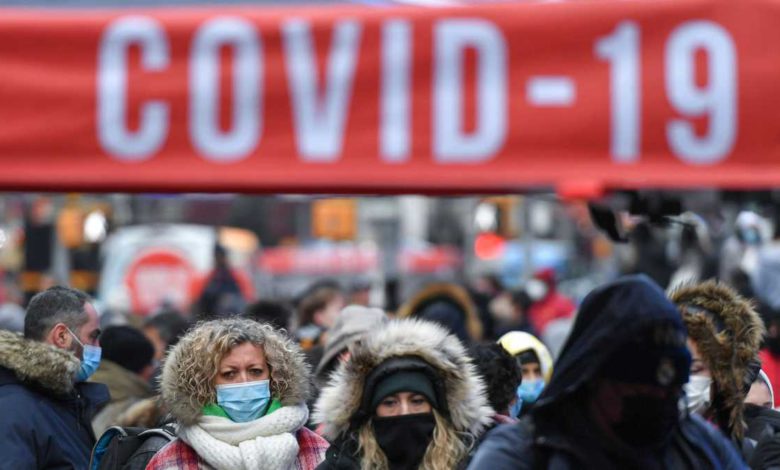

The U.S. hit a seven-day average of 265,427 new COVID-19 cases on Tuesday, blowing past the country's previous record of about 252,000 daily cases, reported nearly a year ago on Jan. 11.The new peak, according to Johns Hopkins University data, comes amid a rapid acceleration of infections in the United States — and across the world — since last month.And experts predict the omicron variant — the most contagious strain of coronavirus yet — is going to make the start of 2022 very difficult."January is going to be a really, really hard month. And people should just brace themselves for a month where lots of people are going to get infected," said Dr. Ashish Jha, dean of the Brown University School of Public Health.And the U.S. could "see half a million cases a day — easy — sometime over the next week to 10 days," CNN medical analyst Dr. Jonathan Reiner said Sunday.Most people who are vaccinated and boosted won't get severe illness, but that won't be true for the unvaccinated, Jha said."A lot of people who have not gotten a vaccine are going to end up getting pretty sick, and it's going to be pretty disruptive," Jha said. "My hope is as we get into February and certainly by the time we get into March, infection numbers will come way down, and it'll also start getting (into) spring, and the weather will start getting better. And that will also help."Despite calls from experts for Americans to get their vaccines and boosters, the rate of booster doses getting administered has fallen in recent weeks — while only 32.7% of the country's fully vaccinated population is boosted.In addition to getting vaccinated and boosted, people can protect themselves by taking precautions in public, Jha said."I would urge people to wear a higher quality mask any time they're in a place with lots of people and they're going to be indoors for any extended period of time," Jha said.A surgical mask might be fine for a quick grocery store trip in an empty store, but for other events, a well-fitting N95 or KF94 mask provides better protection, he said.Looking ahead to New Year's Eve on Friday, small gatherings of fully vaccinated people will be safe, Dr. Anthony Fauci said. But people should avoid large parties where they don't know the vaccination status of all guests, he said."When you are talking about a New Year's Eve party where you have 30, 40, 50 people celebrating, you do not know the status of the vaccination, I would recommend strongly: Stay away from that this year," said Fauci, the director of the National Institute of Allergy and Infectious Diseases. "There will be other years to do that. But not this year."Pediatric hospitalizations nearing previous recordHoliday gatherings, like those over Christmas and New Year's, have some health care workers worried about the impact on children in the coming weeks -- especially those who are too young to be vaccinated."We've just had all of these kids mixing together with everybody else during Christmas," said Dr. Claudia Hoyen, the director of pediatric infection control at UH Rainbow Babies and Children's Hospital in Ohio."We have one more holiday to get through with New Year's, and then we'll be sending everybody back to school. Everybody is kind of waiting on the edge, wondering what we'll end up seeing."Nationwide, pediatric COVID-19 hospitalizations are nearing the record high set in September.On average, roughly 305 children were admitted to the hospital with COVID-19 on any given day over the week that ended Dec. 26, according to data from the Centers for Disease Control and Prevention and the US Department of Health and Human Services.That's more than a 48% jump from the previous week's average and just 10.7% lower than the peak average of 342 children who were admitted to hospitals with the virus that was recorded at the end of August and early September.In New York City, where cases are surging and the average percent positivity rate is continuing to trend upward, pediatric hospitalizations increased five-fold over a three-week period.In Chicago, hospitalizations at one children's hospital have quadrupled. At Children's National Hospital in Washington, D.C., close to half the COVID-19 tests are coming back positive.At Texas Children's Pediatrics & Urgent Care in Houston, the chief medical officer is concerned about the current surge, he said."What's concerning on the (pediatric) side is that, unlike the adults -- where they're reporting for the number of adults getting infected relatively low numbers getting hospitalized — what we're really seeing, we think, is an increasing number of kids being hospitalized," Dr. Stanley Spinner said.Children are an easy target for the virus, said Dr. Juan Salazar, physician in chief at Connecticut Children's Medical Center in Hartford."It's affecting larger communities and it's certainly affecting children in a way that we hadn't seen before," he said. "And that's new compared to last year."CDC updates isolation guidelinesDays after updating its guidance on isolation time for health care workers who test positive for COVID-19, the CDC updated its guidance for the general population.The agency shortened the recommended time for isolation for people with COVID-19 to five days, if asymptomatic, followed by five days of wearing a mask when around others. The prior guidance advised 10 days of isolation."The change is motivated by science demonstrating that the majority of SARS-CoV-2 transmission occurs early in the course of illness, generally in the 1-2 days prior to onset of symptoms and the 2-3 days after," the CDC said in a statement about the updated guidelines.The new recommendations will allow asymptomatic people "to come back to work earlier, and safely, at very low risk," said Dr. William Schaffner, a professor of infectious diseases at Vanderbilt University Medical Center."That will help us in the New Year begin to get our gears back into operation and to function better."The CDC also updated its recommended quarantine period for those exposed to someone with COVID-19.For those who are unvaccinated, have not had a second mRNA dose in more than six months or have not had a booster shot, the CDC recommends quarantining for five days followed by strict mask use for an additional five days.People who have gotten their booster shot do not need to quarantine if they are exposed to COVID-19, but they should wear a mask for 10 days after exposure, the CDC said.The shorter isolation and quarantine guidelines stem from "the extraordinary, unprecedented wave of infections" the United States is seeing and is likely to continue seeing over the next weeks, Fauci told CNN on Tuesday."There is the danger that there will be so many people who are being isolated who are asymptomatic for the full 10 days that you could have a major negative impact on our ability to keep society running," he said.
The U.S. hit a seven-day average of 265,427 new COVID-19 cases on Tuesday, blowing past the country's previous record of about 252,000 daily cases, reported nearly a year ago on Jan. 11.
The new peak, according to Johns Hopkins University data, comes amid a rapid acceleration of infections in the United States — and across the world — since last month.
And experts predict the omicron variant — the most contagious strain of coronavirus yet — is going to make the start of 2022 very difficult.
"January is going to be a really, really hard month. And people should just brace themselves for a month where lots of people are going to get infected," said Dr. Ashish Jha, dean of the Brown University School of Public Health.
And the U.S. could "see half a million cases a day — easy — sometime over the next week to 10 days," CNN medical analyst Dr. Jonathan Reiner said Sunday.
Most people who are vaccinated and boosted won't get severe illness, but that won't be true for the unvaccinated, Jha said.
"A lot of people who have not gotten a vaccine are going to end up getting pretty sick, and it's going to be pretty disruptive," Jha said. "My hope is as we get into February and certainly by the time we get into March, infection numbers will come way down, and it'll also start getting (into) spring, and the weather will start getting better. And that will also help."
Despite calls from experts for Americans to get their vaccines and boosters, the rate of booster doses getting administered has fallen in recent weeks — while only 32.7% of the country's fully vaccinated population is boosted.
In addition to getting vaccinated and boosted, people can protect themselves by taking precautions in public, Jha said.
"I would urge people to wear a higher quality mask any time they're in a place with lots of people and they're going to be indoors for any extended period of time," Jha said.
A surgical mask might be fine for a quick grocery store trip in an empty store, but for other events, a well-fitting N95 or KF94 mask provides better protection, he said.
Looking ahead to New Year's Eve on Friday, small gatherings of fully vaccinated people will be safe, Dr. Anthony Fauci said. But people should avoid large parties where they don't know the vaccination status of all guests, he said.
"When you are talking about a New Year's Eve party where you have 30, 40, 50 people celebrating, you do not know the status of the vaccination, I would recommend strongly: Stay away from that this year," said Fauci, the director of the National Institute of Allergy and Infectious Diseases. "There will be other years to do that. But not this year."
Pediatric hospitalizations nearing previous record
Holiday gatherings, like those over Christmas and New Year's, have some health care workers worried about the impact on children in the coming weeks -- especially those who are too young to be vaccinated.
"We've just had all of these kids mixing together with everybody else during Christmas," said Dr. Claudia Hoyen, the director of pediatric infection control at UH Rainbow Babies and Children's Hospital in Ohio.
"We have one more holiday to get through with New Year's, and then we'll be sending everybody back to school. Everybody is kind of waiting on the edge, wondering what we'll end up seeing."
Nationwide, pediatric COVID-19 hospitalizations are nearing the record high set in September.
On average, roughly 305 children were admitted to the hospital with COVID-19 on any given day over the week that ended Dec. 26, according to data from the Centers for Disease Control and Prevention and the US Department of Health and Human Services.
That's more than a 48% jump from the previous week's average and just 10.7% lower than the peak average of 342 children who were admitted to hospitals with the virus that was recorded at the end of August and early September.
In New York City, where cases are surging and the average percent positivity rate is continuing to trend upward, pediatric hospitalizations increased five-fold over a three-week period.
In Chicago, hospitalizations at one children's hospital have quadrupled. At Children's National Hospital in Washington, D.C., close to half the COVID-19 tests are coming back positive.
At Texas Children's Pediatrics & Urgent Care in Houston, the chief medical officer is concerned about the current surge, he said.
"What's concerning on the (pediatric) side is that, unlike the adults -- where they're reporting for the number of adults getting infected relatively low numbers getting hospitalized — what we're really seeing, we think, is an increasing number of kids being hospitalized," Dr. Stanley Spinner said.
Children are an easy target for the virus, said Dr. Juan Salazar, physician in chief at Connecticut Children's Medical Center in Hartford.
"It's affecting larger communities and it's certainly affecting children in a way that we hadn't seen before," he said. "And that's new compared to last year."
CDC updates isolation guidelines
Days after updating its guidance on isolation time for health care workers who test positive for COVID-19, the CDC updated its guidance for the general population.
The agency shortened the recommended time for isolation for people with COVID-19 to five days, if asymptomatic, followed by five days of wearing a mask when around others. The prior guidance advised 10 days of isolation.
"The change is motivated by science demonstrating that the majority of SARS-CoV-2 transmission occurs early in the course of illness, generally in the 1-2 days prior to onset of symptoms and the 2-3 days after," the CDC said in a statement about the updated guidelines.
The new recommendations will allow asymptomatic people "to come back to work earlier, and safely, at very low risk," said Dr. William Schaffner, a professor of infectious diseases at Vanderbilt University Medical Center.
"That will help us in the New Year begin to get our gears back into operation and to function better."
The CDC also updated its recommended quarantine period for those exposed to someone with COVID-19.
For those who are unvaccinated, have not had a second mRNA dose in more than six months or have not had a booster shot, the CDC recommends quarantining for five days followed by strict mask use for an additional five days.
People who have gotten their booster shot do not need to quarantine if they are exposed to COVID-19, but they should wear a mask for 10 days after exposure, the CDC said.
The shorter isolation and quarantine guidelines stem from "the extraordinary, unprecedented wave of infections" the United States is seeing and is likely to continue seeing over the next weeks, Fauci told CNN on Tuesday.
"There is the danger that there will be so many people who are being isolated who are asymptomatic for the full 10 days that you could have a major negative impact on our ability to keep society running," he said.
Source link







